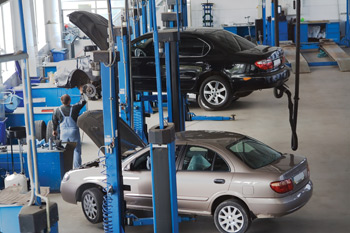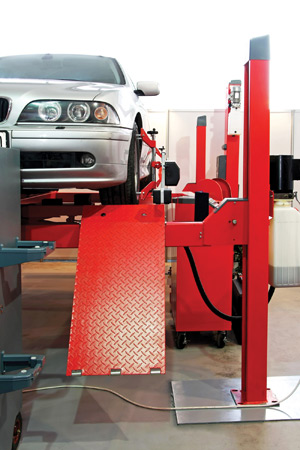Equipment is one of those things in the workplace that we only think about when it isn’t working. How excited can you get about lifting equipment really? Well I agree, but I am going to do my best to make this an uplifting experience!

Pump It Up
There are two types of portable jacks — hydraulic and non-hydraulic. Hydraulic jacks use fluid such as oil to do work, and allow the user to lift more weight with less input of force. Hydraulic jacks come in both air assisted and non-air assisted types. By using air to apply this force, the jack pressure can be raised by many times. If you plan on lifting big equipment or trucks frequently, it probably makes sense for you to invest in air-assisted jacks. These will generally be more expensive than a non-air-assisted jack, but the extra capacity is well worth the cost.
Jacks come in many different forms. There are bottle jacks, floor or service jacks and specialty application jacks. In most cases, the job will determine what kind of jack you need to use. Factors such as clearance, weight of the item you need to lift, the surface you are working on, the availability of air, and how long you need to lift the item, will affect your final choice.
Bottle Jacks
Bottle jacks are a good choice in confined spaces or where you need portability. Bottle jacks are extremely powerful. Pound for pound they are probably the champions. Little more than hydraulic rams with no frills, bottle jacks are designed to sit where you put them and go up and down. There are no bells or whistles, and while some have wheels on them, most don’t. These relatively compact jacks are capable of lifting weights as much as 100 tons!
Floor/Service Jacks
Floor jacks and service jacks are terms used to describe the same item. They are generally mounted on wheels to allow the technician to move the jack easily. This type of jack is offered in a wide range of capacities from as little as 1/2 ton up to as much as 100 tons.
Specialty Application Jacks
Time is money, so any time savings you can find in the shop is usually well worth the cost of the equipment. A feature to look for when thinking about time-savings with specialty jacks is “pumps to load.” This means how many times you have to pump the jack to get it to touch the bottom of whatever you are raising. This is one of the biggest time killers when using a floor jack. The latest jacks have special valving that raises the lifting saddle in just a few strokes. Some high-end jacks will reach the load in one to three pumps, as opposed to 15-20 on the older-style jacks. Some models of floor jacks now have two main cylinders instead of the traditional single ram. This effectively doubles the amount of fluid that can be pumped on each stroke, which cuts the number of strokes required. Again, expect to pay more for double ram jacks, but the time savings may be well worth it.
Specifications/Construction Details
When deciding on a jack, there are several specifications and measurements you want to think about. An obvious one is capacity. This is the first number that manufacturers will always tell you. Expressed in tons, this will typically be a whole number. Like any numbers game, always check the fine print, as specs are sometimes rounded up. This usually is only a problem on non-name-brand economy products. The larger suppliers are very conservative and will usually understate, rather than overstate, the capacity of their lifting equipment. It’s just not worth it to a good manufacturer to take the risk and fudge the capacity of its jacks. If someone was to ever get hurt, and it turned out that the supplier had misstated capacity, it could cost the company everything.
In the last several years, the low height measurement of jacks has become more important. This is the height of the jack with the lifting saddle in the down position. This started becoming critical in the early ’90s as low rider vehicles became more and more popular. As is always the case, street designs found their way into the OEMs. Now, it is common to see brand new cars with 50 series tires and ground effects. For that reason, you need to pay attention to the low height of that next potential jack.
The high height is not critical to everyone, but you should think about it if you work on trucks. Even stock two-wheel-drive trucks are now coming with 16” wheels that can make the vehicle challenging to lift with some jacks.

Installed Lifting Equipment
Due to the weight of the item and the lifting capacity, this product is normally bolted to the floor of the shop or garage.
The first automotive lifts were inspired by the common barber’s chair. An entrepreneur noticed how easy it was to spin a chair with a person sitting in it, and thought that would make a great solution for working on vehicles. For many years, automotive lifts were designed with large hydraulic cylinders that went down into the floor. While highly effective, these lifts were hard to work on, messy and not terribly friendly to the environment.
A Series of Twos
There are two main types of lifts to consider. They are above-ground and in-ground lifts. Both of these lift styles have pros and cons. We will start with the above-ground lifts. These lifts are the easier product to install, erected on top of the shop floor. The main concerns to be addressed with above-ground lifts are: available floor space, ceiling height, power availability and floor thickness.
Because of the way that these lifts are installed and constructed, they are perfect for installing in an existing shop or garage. They are less expensive than in-ground lifts, and less expensive to install. The downside of using above-ground lifts is that they are not as “clean” an installation. In other words, they are not as neat or aesthetically attractive as in-ground lifts. Above-ground lifts have visual negatives such as overhead wiring, rigging and/or obstacles on the floor. The only two options for the power and hydraulics are to either run them on the floor from side to side or above. While some shop owners would not care about aesthetics, if you’re envisioning a high-end look, you may want to consider an in-ground lift. I will go into greater detail about in-ground lifts later in the article.
There are two main classes of above-ground lifts in use today — two-post and four-post lifts. Two-post lifts take up less space than four-post lifts, which is especially important in small garages or in dealership installations where you are trying to get as many lifts as possible in a small space. Installation is usually pretty easy. If the floor is level and thick enough, a two-post lift can be installed in a half day in most cases. The hardest part of the installation is waiting for the electrician to show up to wire the electricity.
There are two types of two-post lifts. (Are you noticing a pattern of twos here?) There are symmetrical and asymmetrical lifts. Basically the difference is that one of these lift types has equal-length lifting arms and is symmetrical. (Balanced, from side to side.) The asymmetrical lift has two arms that are longer than the other, or unbalanced. (Please, no letters of correction from you engineering types out there!) Symmetrical lifts are great for most uses; they lift average passenger cars well. One downside to this configuration is that they don’t do a great job of lifting vehicles with uneven weight distribution. One such vehicle is the modern-day pickup truck. This vehicle is much heavier in the front of the vehicle due to the weight of the engine and transmission. If your shop does a lot of service on pickups, you are going to want to look at the asymmetrical lift configuration.
The uneven arm lengths of an asymmetrical lift changes the weight distribution on the lift. It basically compensates for the vehicle’s “unevenness.” By shortening up two of the arms, the weight is moved closer to the midline of the lift. This assures that the lift can safely lift vehicles like pickups.
Another advantage of asymmetrical lifts is that you can get more of this style lift in the same space because the lifts can be placed closer together than symmetrical lifts.
Four on the Floor
Four-post lifts are workhorses built for very specific jobs, such as wheel alignment. In order to be able to read and correct wheel angles, you have to have a stable and even lifting platform. You also have to be able to make adjustments on steering components while the vehicle is sitting on its tires. The four-post above-ground lift is the perfect solution for this job.
Four-post lifts are also a great choice for specialty jobs where the technician needs clear access to the underside of the car. Two applications that benefit from drive-on, four-post lifts are exhaust and transmission shops. Four-post lifts are also the first choice for lifting extremely heavy and/or long vehicles. Work trucks, heavy-duty trucks and limousines are just some of the vehicles that are well served by four-post lifts.
Underneath it All
In-ground lifts, as I mentioned earlier, have some very attractive aspects to them that you may want to consider. Once upon a time, in-ground lifts could only be installed when the shop was being built. This was because the floor had to be poured to accommodate the lift, special construction was needed and the cost was high. While not as simple as installing an above-ground lift, today’s modern in-ground lifts are much easier to install than they used to be and can even be retrofitted to a building after the construction is complete.
Another concern about in-ground lifts — oil leaking or contaminating the ground water — is today almost non-existent. The reason? Far less fluid being used than before, non-oil-based fluids are available, and most of the in-ground designs now use liners and containment systems to make sure there is no chance for any leakage.
One real advantage of in-ground lifts is the floor is completely clear under the car when it is raised, and when the lift is lowered, the shop is much more open without the posts and wiring in the air. It really comes down to the shop owner’s preference as well as budget, space available and types of service performed as to which style of lift is better.
As you can see, there are a lot of choices and decisions to be made when looking at lifting equipment. Whether you are shopping for a 1-ton floor jack or a 20-ton, two-post lift, it comes down to the same main questions: How much do you need to lift? How high do you need to lift it? And how much room do you need to work on the item?
